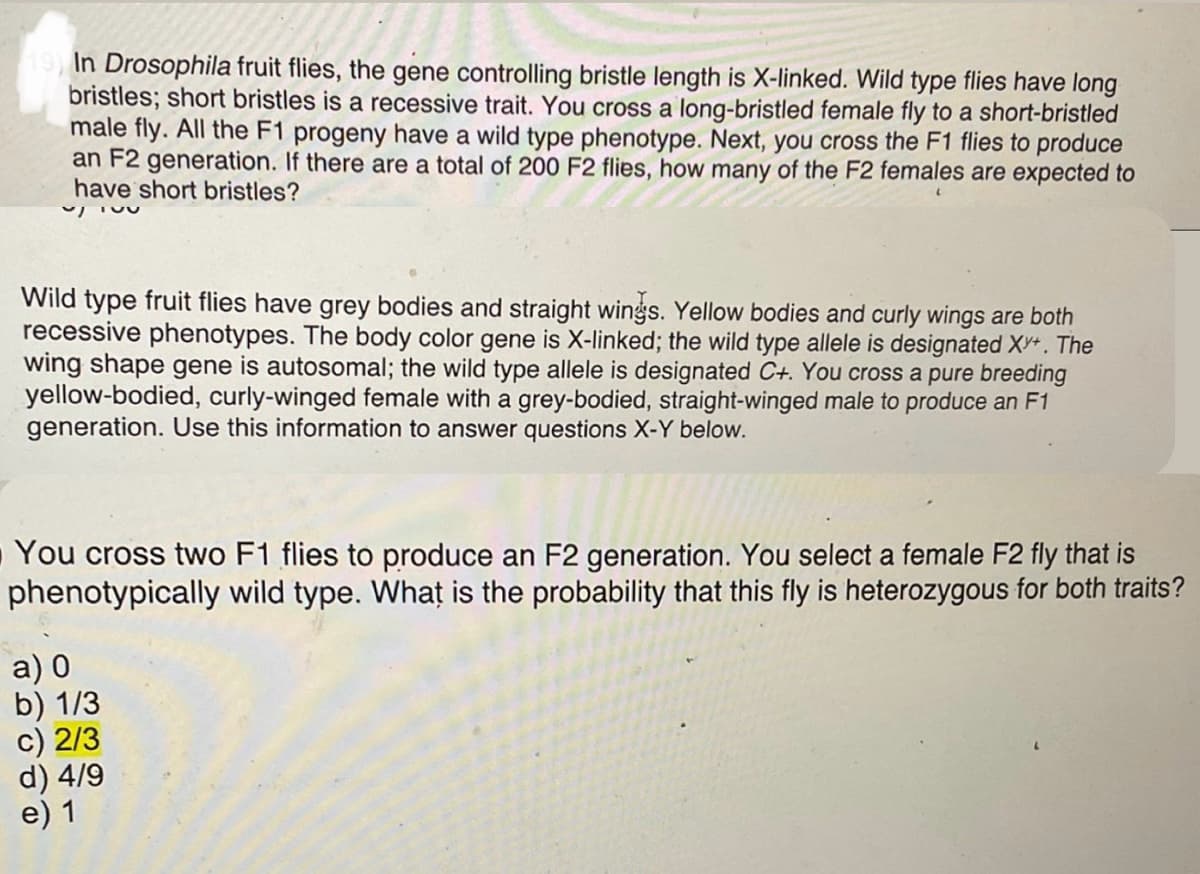In Drosophila fruit flies, the gene controlling bristle length is X-linked. Wild type flies have long bristles; short bristles is a recessive trait. You cross a long-bristled female fly to a short-bristled male fly. All the F1 progeny have a wild type phenotype. Next, you cross the F1 flies to produce an F2 generation. If there are a total of 200 F2 flies, how many of the F2 females are expected to have short bristles?
In Drosophila fruit flies, the gene controlling bristle length is X-linked. Wild type flies have long bristles; short bristles is a recessive trait. You cross a long-bristled female fly to a short-bristled male fly. All the F1 progeny have a wild type phenotype. Next, you cross the F1 flies to produce an F2 generation. If there are a total of 200 F2 flies, how many of the F2 females are expected to have short bristles?
Biology: The Dynamic Science (MindTap Course List)
4th Edition
ISBN:9781305389892
Author:Peter J. Russell, Paul E. Hertz, Beverly McMillan
Publisher:Peter J. Russell, Paul E. Hertz, Beverly McMillan
Chapter13: Genes, Chromosomes, And Human Genetics
Section: Chapter Questions
Problem 8TYK: Another gene in Drosophila determines wing length. The dominant wild-type allele of this gene...
Related questions
Question

Transcribed Image Text:19) In Drosophila fruit flies, the gene controlling bristle length is X-linked. Wild type flies have long
bristles; short bristles is a recessive trait. You cross a long-bristled female fly to a short-bristled
male fly. All the F1 progeny have a wild type phenotype. Next, you cross the F1 flies to produce
an F2 generation. If there are a total of 200 F2 flies, how many of the F2 females are expected to
have short bristles?
V/100
Wild type fruit flies have grey bodies and straight wings. Yellow bodies and curly wings are both
recessive phenotypes. The body color gene is X-linked; the wild type allele is designated XY+. The
wing shape gene is autosomal; the wild type allele is designated C+. You cross a pure breeding
yellow-bodied, curly-winged female with a grey-bodied, straight-winged male to produce an F1
generation. Use this information to answer questions X-Y below.
You cross two F1 flies to produce an F2 generation. You select a female F2 fly that is
phenotypically wild type. What is the probability that this fly is heterozygous for both traits?
a) 0
b) 1/3
c) 2/3
d) 4/9
e)
Expert Solution
This question has been solved!
Explore an expertly crafted, step-by-step solution for a thorough understanding of key concepts.
This is a popular solution!
Trending now
This is a popular solution!
Step by step
Solved in 3 steps

Knowledge Booster
Learn more about
Need a deep-dive on the concept behind this application? Look no further. Learn more about this topic, biology and related others by exploring similar questions and additional content below.Recommended textbooks for you

Biology: The Dynamic Science (MindTap Course List)
Biology
ISBN:
9781305389892
Author:
Peter J. Russell, Paul E. Hertz, Beverly McMillan
Publisher:
Cengage Learning

Biology: The Dynamic Science (MindTap Course List)
Biology
ISBN:
9781305389892
Author:
Peter J. Russell, Paul E. Hertz, Beverly McMillan
Publisher:
Cengage Learning